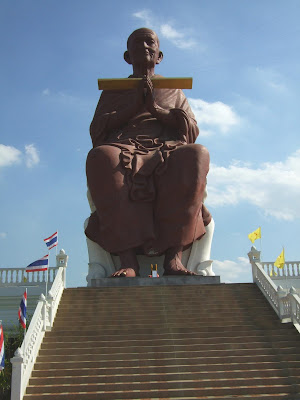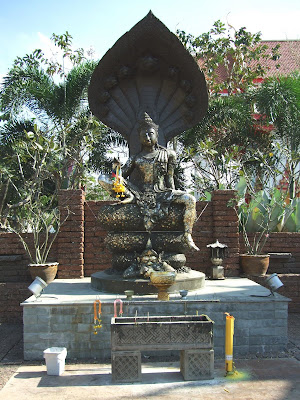
Bang
Rajan is the famous historical battleground in
Singburi province where around 400 patriotic villagers held off a Burmese invading army of 100,000 for 5 months before it was completely destroyed in the year 1765 CE. The armies of King
Mang Ra were repelled for 7 times by the heavily outnumbered and under-equipped village fighters. Only at the 8
th attempt did they succeed in obliterating the villagers, who fought till the very end. Their destruction was inevitable because they did not receive any reinforcements from
Ayuttaya despite requesting for them.
Ayuttaya's failure to help eventually led to its conquest by the Burmese 2 years later, razing the entire city to the ground. Above we see the monument at Camp Bang
Rajan to
commemorate these patriots.

And this is Wat
Pho Kao Ton, the temple venerating
Ajarn Thammachot, the spiritual leader of the Bang
Rajan village fighters. Ever since that era, the Bang
Rajan battleground had been haunted by the ghosts of the patriots, who died with anger in their minds. They were reborn as
Petas, and through the power of their anger they continued to guard the land even in the afterlife. They became fierce "earth-bound spirits" and for 200 over years nobody could take anything away from that place.

The
Vihara of
Ajarn Thammachot.

The statue of
Ajarn Thammachot inside the
Vihara, covered with gold foil.
Ajarn Thammachot played an important psychological role in the battle as he provided spells and amulets of "
Kongkapan" or
invulnerability for the protection of the fighters, who had no armour but great faith in his magic powers. He was not a native of
Singburi, but was a monk from the neighbouring province of
Suphanburi invited to reside at Bang Rajan.
Ajarn Thammachot was skilled in
Jhana meditation as well as the
Wicha of protective spells and incantations. Above all he was a great spiritual leader who inspired the village fighters never to give up.

As we can see on the statues of the resistance leaders, they wear vests with protective
Yants drawn on them as their "armour".
 Roop Lor
Roop Lor amulets of
Ajarn Thammachot available at the temple counter. However even with all the protection, it was still not enough against overwhelming odds and
Ajarn Thammachot was killed along with the destruction of Bang
Rajan. He too became one of the angry
Petas guarding the place beyond death. This tells us that no amount of magic or psychic powers can resist the Law of Karma, which must come to fruition one way or another when the time is ripe. It was like
Ven Mogallana, the Buddha's chief disciple who was pummelled to death by jealous heretics despite being foremost in psychic powers.

This is the well where
Ajarn Thammachot used to make holy water to bless the village warriors before they went to battle. But coming back to the topic of the
Petas, anybody who had stolen anything from the battleground had to return it because of the bad luck that followed. When people tried to take water from
Ajarn Thammachot's well to put in their car radiator, the radiator exploded.

These are
Chedis built for the slain Burmese soldiers. Anyone who tried to take carved bricks from the area (to make amulets or simply for
remembrance) also had to bring the bricks back to their
original spot. However my Master LP
Jarun of Wat
Ampawan was somehow able to obtain one such brick from the provincial governor of
Singburi, Mr
Pook Rikkasem many years ago. Other people were not so lucky. LP related in one of his books the story of the late
Sangha head of
Dermbang Nangbuat district in
Suphanburi, who also tried to obtain some of those bricks in the past. At that time he stayed at Wat
Ampawan for one night and took a motorbike ride to the battleground the following morning. After collecting some bricks to put in his kit bag, he proceeded back to
Suphanburi. But just before he could cross into the province, the motorbike skidded while making a left turn at Ta Chang market. The
Sangha head got a cut on his head. But he picked up the bricks and stayed over at his sister's house at a nearby sugarcane farm. That night, there were loud mysterious cries heard throughout - the
Petas of Bang
Rajan were wailing for the return of their property. So the
Sangha head had no choice but to return them the next morning.

The story of Bang
Rajan was immortalized in the Year 2000 movie "Bang
Rajan" by director
Thanit Jitnukun.
 On my way back to Bangkok from Ayuttaya, I visited Wat Bot in Pathum Thani. This is a relatively new temple famous for its giant statue of Somdej Toh reading scripture.
On my way back to Bangkok from Ayuttaya, I visited Wat Bot in Pathum Thani. This is a relatively new temple famous for its giant statue of Somdej Toh reading scripture. The Sala with a smaller statue. This is were people place their offerings to Somdej Toh. The giant statue is in the background. The Somdej Toh Katha taught here is as follows:
The Sala with a smaller statue. This is were people place their offerings to Somdej Toh. The giant statue is in the background. The Somdej Toh Katha taught here is as follows: Walking up to the statue, I look up in awe at one of the most venerated monks in Thai history.
Walking up to the statue, I look up in awe at one of the most venerated monks in Thai history. A view from the right side of the statue.
A view from the right side of the statue. Pay homage at the feet of Somdej Phra Puttajarn Toh.
Pay homage at the feet of Somdej Phra Puttajarn Toh. The Jatukam image in the courtyard.
The Jatukam image in the courtyard.









 Arriving at the temple with my driver.
Arriving at the temple with my driver.






 The crystal
The crystal 

 This is the 5"
This is the 5" 

 Finally meeting LP Maen in Jun 2009.
Finally meeting LP Maen in Jun 2009. 


 And this is Wat
And this is Wat  The
The  The statue of
The statue of  As we can see on the statues of the resistance leaders, they wear vests with protective
As we can see on the statues of the resistance leaders, they wear vests with protective 
 This is the well where
This is the well where  These are
These are  The story of Bang
The story of Bang  Mr
Mr  On 29
On 29  This act of merit confirmed the saying in the
This act of merit confirmed the saying in the  Bang
Bang 





